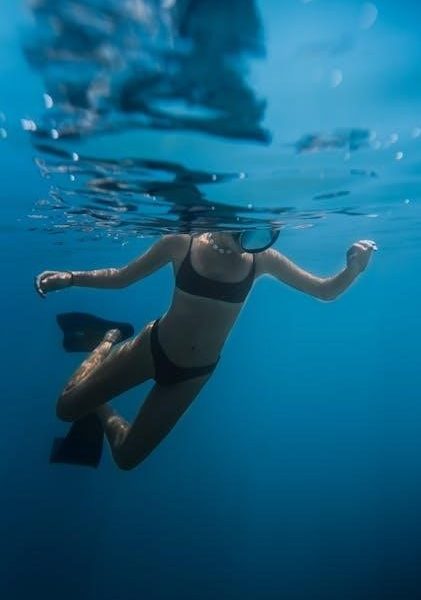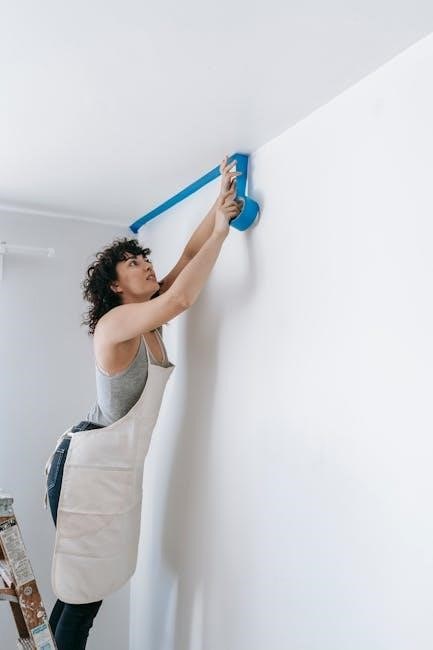
women’s wetsuit size guide
Discover the ultimate guide to finding your perfect women’s wetsuit size. This comprehensive resource helps you navigate sizing charts, measurements, and fit tips for optimal comfort and performance in the water.
1.1 Importance of Proper Fit in Women’s Wetsuits
A proper-fitting women’s wetsuit is essential for both performance and comfort. It ensures minimal water entry, retaining body heat and reducing flushing, which can make you cold. A snug fit also enhances flexibility, allowing better movement during activities like surfing or diving. Conversely, a wetsuit that is too tight or too loose can restrict mobility, cause discomfort, or lead to chafing. Achieving the right balance ensures optimal functionality, making it vital to focus on accurate sizing and personal comfort preferences when selecting your wetsuit.
1.2 How to Use This Guide Effectively
This guide is designed to simplify your search for the perfect women’s wetsuit. Start by reviewing the size charts from various brands, noting key measurements like height, weight, chest, waist, hips, and inseam. Use a flexible tape measure to take accurate body measurements, ensuring the tape is snug but not tight. If your measurements fall between sizes, consider sizing up for comfort. Cross-reference your data with brand-specific charts, as sizing can vary. Don’t hesitate to consult customer support if unsure, and remember, the right fit balances comfort and performance seamlessly.
Understanding Women’s Wetsuit Measurements
Accurate measurements, including height, weight, chest, waist, hips, and inseam, are crucial for determining the right wetsuit size. These metrics form the basis of size charts.
2.1 Key Measurements for Sizing: Height, Weight, Chest, Waist, Hips, and Inseam
Height, weight, chest, waist, hips, and inseam are essential for accurate sizing. Height and weight provide primary indicators, while chest, waist, hips, and inseam ensure a secure, comfortable fit. These measurements guide size selection across brands, ensuring optimal performance and comfort in the water. Proper sizing prevents excessive water entry and enhances mobility. Always refer to specific charts for precise fit.
2.2 How to Take Your Measurements Accurately
To ensure the best fit, measure yourself with a flexible tape measure. Wear minimal clothing for precise results. Measure height standing straight, weight on both feet. Chest circumference is taken at the bust’s fullest point, keeping the tape level. Waist is measured at the narrowest point, and hips at the widest. Inseam is from the crotch to the bottom of the heel. Take measurements while standing up straight and relaxed. Double-check each measurement for accuracy to match with size charts effectively.

Key Factors Determining Women’s Wetsuit Size
Key factors include height, weight, chest, waist, hips, and inseam measurements, ensuring a snug, comfortable fit that maximizes performance and warmth in the water.
3.1 Height and Weight as Primary Indicators
Height and weight are crucial for determining the ideal wetsuit size, as they provide a foundational measure of body proportions. Typically, height ranges from 53-59 inches, correlating with weight ranges of 100-155 lbs, ensuring a balanced fit. For instance, a woman measuring 53-55 inches tall and weighing 100-120 lbs would likely fit a size 2, while someone taller (57-59 inches) and heavier (140-155 lbs) might opt for a size 10T. These metrics help align the wetsuit’s length and thickness with the user’s body, ensuring both comfort and performance in the water.
3.2 Chest and Waist Measurements for a Secure Fit
Chest and waist measurements are vital for ensuring a snug, secure fit. Chest sizes typically range from 30.5 to 37 inches, while waists range from 23 to 27 inches. For example, a size 2 wetsuit accommodates a chest of 30.5-32;5 inches and a waist of 23-25 inches, while a size 10 fits a chest of 34-37 inches and a waist of 24-27 inches. Accurate measurements ensure the wetsuit sits comfortably without gaping, providing warmth and flexibility. Use a flexible tape measure, keeping it level and not too tight, to determine your size accurately.
3.3 Hips and Inseam: Ensuring Comfort and Mobility
Hips and inseam measurements are key for comfort and mobility. Hips typically range from 33-35 inches for smaller sizes to 42-46 inches for larger sizes. Inseam lengths vary from 27-28 inches for petite fits to 30-32 inches for taller sizes. Proper hip fit prevents restrictive movement, while inseam length ensures the wetsuit legs aren’t too short or long, maintaining comfort and flexibility. Measure hips at the widest point and inseam from the crotch to ankle for accuracy. This ensures a balanced fit, allowing freedom of movement for water activities.
Common Fit Issues and Solutions
Addressing fit issues ensures optimal performance and comfort. If your wetsuit is too tight, consider sizing up. For a loose fit, opt for a smaller size. Adjustments like choosing the next size up if between sizes can resolve discomfort. Ensure the wetsuit isn’t restrictive around the neck or shoulders, as this can hinder movement. Proper fit prevents water flushing, keeping you warm and mobile during water activities. Balancing snugness and flexibility is key for the best experience.
4.1 What to Do If You’re Between Sizes
If your measurements fall between two sizes, it’s best to choose the next larger size for comfort and mobility. A wetsuit that’s too tight can restrict movement, while one that’s too loose may allow water to flush in, reducing warmth. Consider your height, weight, and body type when deciding. For example, if you’re closer to the upper height or weight limit, sizing up ensures a better fit. Refer to size charts from brands like ION, NP, or Billabong for guidance, as they often recommend sizing up in such cases to ensure optimal performance and comfort in the water.

4.2 How to Avoid a Wetsuit That Is Too Tight or Too Loose
A wetsuit should fit snugly, like a second skin, without feeling restrictive. To avoid a wetsuit that’s too tight, ensure there’s no discomfort or difficulty moving. If it’s too loose, water can flush in, reducing warmth. Check size charts and consider your height, weight, and body type. If unsure, sizing up slightly can provide a better fit. Brands like ION and NP recommend choosing the next size if measurements are borderline. Always try the wetsuit on if possible, and refer to brand-specific charts for the most accurate fit.

How to Choose the Right Size for Your Body Type
Find your perfect fit by considering petite, tall, or curvier options. Use size charts to match your body type, ensuring comfort and performance in the water.
5.1 Petite, Tall, and Curvier Fits: Finding Your Match
Petite women should look for styles with shorter inseams and tailored cuts. Tall individuals may prefer longer torsos for comfort. Curvier figures can opt for high-waisted designs or plus-size options that offer a secure fit without compromising mobility. Use size charts to identify measurements that align with your body type, ensuring a comfortable and flattering fit. Consider brands that cater to diverse body types for the best match. Proper fit enhances performance and confidence in the water.
5.2 When to Size Up for Comfort and Performance
If your measurements fall on the higher end of a size range, consider sizing up for a more comfortable fit. This is especially true for curvier figures or those with broader shoulders. A slightly looser wetsuit allows better mobility, essential for active water sports. However, avoid sizing up too much, as it may lead to a loose fit that compromises warmth and performance. Always consult the size chart and focus on chest and waist measurements for the best fit. Balancing comfort and snugness ensures optimal performance in the water.

EU, US, and AU Size Comparisons
EU, US, and AU sizes differ significantly. Understanding these comparisons helps bridge regional sizing gaps, ensuring an accurate fit for women’s wetsuits.
6.1 Converting Sizes Across Different Regions
Converting wetsuit sizes between EU, US, and AU can be tricky due to differing regional sizing standards. EU sizes typically start at 34 (XXS) and increase incrementally, while US sizes begin at 4 (XS). Australian sizes often align closely with US measurements but may vary slightly. For example, an EU size 36 (S) might correspond to a US size 6 (S) and an AU size 8 (S). Understanding these correlations is crucial for selecting the correct size when shopping across regions.
Height and weight play significant roles in these conversions. Always refer to brand-specific size charts for accurate comparisons, as some brands may differ slightly. If unsure, sizing up is generally recommended for comfort and performance.
6.2 Understanding Size Charts from Popular Brands
Popular brands like ION, NP, and Billabong offer detailed size charts tailored to their designs. For example, ION’s size S corresponds to chest measurements of 32-35 inches, while NP’s S size ranges from 34-37 inches. These variations highlight the importance of checking brand-specific charts. Always compare your measurements to the brand’s guidelines, as sizing can differ significantly. If you’re between sizes, most brands recommend sizing up for comfort and performance. Referencing these charts ensures a precise fit, whether you’re shopping from Mystic, O’Neill, or other top labels.
Additional Features to Consider
Explore key features like hoods, plus-size options, and unique seam constructions that enhance comfort and durability, ensuring your wetsuit meets both functional and personal style needs.
7.1 Hooded Wetsuits: Sizing and Fit Differences
Hooded wetsuits offer enhanced warmth and protection from the elements. When sizing, ensure the hood fits snugly around your head and neck to prevent water entry. The added material may slightly alter the overall fit, so consider your usual size but check measurements carefully. Some brands recommend sizing up if you’re between sizes to ensure comfort and mobility. Additionally, hooded wetsuits may have slightly different chest and shoulder measurements due to the integrated design, so compare these dimensions closely with your body measurements for the best fit.
7.2 Plus-Size Options: Finding the Perfect Fit
Plus-size women’s wetsuits are designed to provide comfort and confidence in the water. Look for brands that offer extended sizing options, ensuring a flattering and functional fit. When choosing, prioritize accurate measurements, as a well-fitted wetsuit is essential for warmth and performance. Some brands recommend sizing up if you’re between sizes to ensure mobility and comfort. Check size charts specific to plus-size ranges and read reviews to find the best fit for your body type. Proper fit ensures optimal performance and enjoyment in the water.
Care and Maintenance for Longevity
Properly caring for your wetsuit ensures longevity. Rinse with cold water, avoid harsh chemicals, and store in a cool, dry place. Regular maintenance keeps it performing well.
8.1 How to Properly Care for Your Wetsuit
To extend the life of your wetsuit, rinse it with cold water after each use to remove salt, sand, and bacteria. Avoid exposing it to direct sunlight or heat, as this can cause neoprene to degrade. Use a mild detergent or wetsuit-specific cleaner for deeper cleans. Store your wetsuit flat or on a hanger to prevent stretching or creasing. Allow it to dry thoroughly before storing to avoid mildew. Regular maintenance ensures your wetsuit remains flexible, warm, and durable for future adventures.
8.2 Maintaining the Fit Over Time
To ensure your wetsuit retains its fit and performance, avoid excessive stretching and tight storage. After use, rinse thoroughly and dry away from direct sunlight to prevent neoprene degradation. Regularly inspect for signs of wear, such as thinning or cracks, and repair minor damage promptly. Store your wetsuit flat or on a broad hanger to maintain its shape. Over time, minor adjustments to your care routine can help preserve the fit, keeping your wetsuit comfortable and functional for seasons to come.
Choosing the right women’s wetsuit size ensures comfort, performance, and warmth. By following this guide, you’ll make informed decisions, ensuring a perfect fit for your water adventures.
9.1 Final Tips for Choosing the Best Women’s Wetsuit
For the best fit, prioritize proper measurements and size charts. Consider height, weight, and body type to ensure a snug yet comfortable wetsuit. If between sizes, opt for the next larger size. Check for features like hoods or plus-size options based on your needs. Always refer to brand-specific charts, as sizing can vary. Finally, maintain your wetsuit properly to preserve its fit and extend its lifespan for years of enjoyable water adventures.
Leave a Reply
You must be logged in to post a comment.